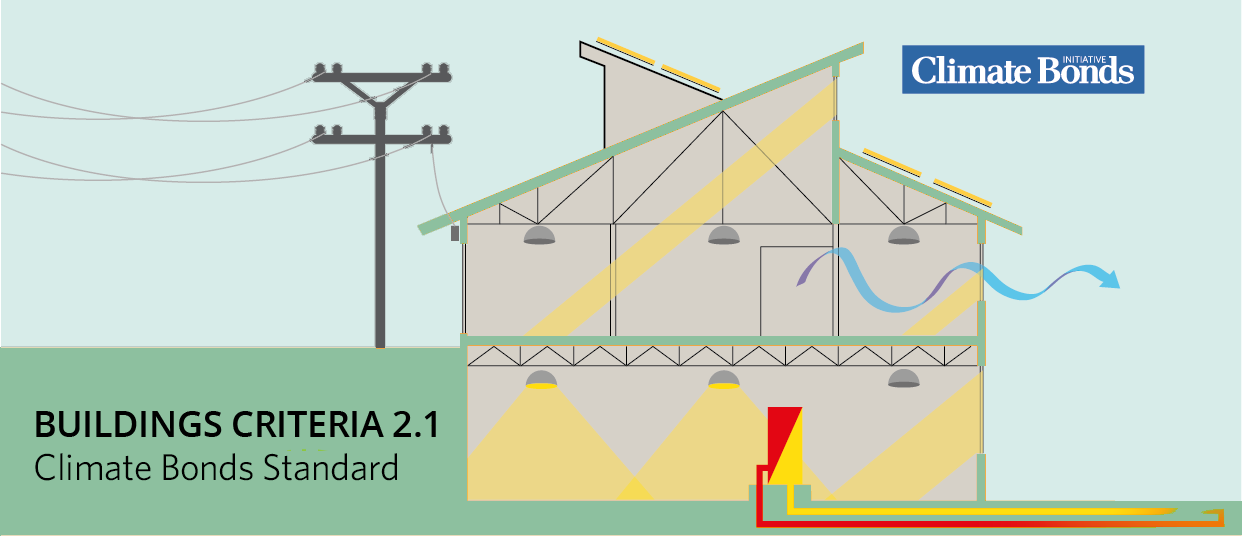
Status: Buildings Criteria 2.1. is now available for Certification. The Criteria have expanded the scope to New Buildings and are in line with the EU Taxonomy.
Supporting documents
- Guidance to Scope 3 Emissions and Accounting
- Whitelist for Green Buildings Technologies
- EU Taxonomy Technical Guidance Note
Read more about the EU Taxonomy and embodied carbon
Building typology
- Trajectory Methodology
- Extrapolation Methodology
- Proxy Methodology
- Upgrade Methodology
- Frequently Asked Questions
Certification
To see the whole list of Low Carbon Buildings Climate Bonds, visit our Database of Certified Bonds
What are the Building Criteria
Climate Bonds Initiative have developed definitions for what constitutes a green activity or investment to facilitate the issuer’s issuance and market screening methodologies that monitor and record issuances across the full spectrum of labels (the GSS+). This in turn indicates the pathway to raising capital to support decarbonisation in various sectors and hard to abate industries. Energy use according to Ritchie (2020) accounts for more than 70% Greenhouse Gas Emissions with Industry at 24.2%, Transport 16.2% and Buildings 17.5%.[i]
Financial instruments (bonds and loans) linked to these eligible assets, activities and entities will be aligned with the Paris Agreement and the goal of keeping global temperature rises to no more than 1.5oC above pre-industrial levels.
They are divided into three different types:
- Commercial Buildings: buildings used for office, retails, hospitals, hotels and universities
- Residential Buildings: buildings used for housing that includes single family, multi-family, and mixed use where more than 50% of the asset is residential. Subcategories of residential buildings have unique emissions performance profiles. Existing instruments such as local building codes, energy rating schemes (e.g. US Energy Star) and energy labeling schemes (e.g. Energy Performance Certificates in the EU) are leveraged as emission performance proxies (using the proxy methodology).
- Upgrade Projects: Commercial, residential and some other types of buildings can be eligible for Certification, if they achieve an emission reduction of 30%-50% (depending on bond term) from a baseline.
The Low-Carbon Buildings Criteria pertain to eligible assets and projects related to building investments, encompassing both commercial and residential properties with the potential to meet the stringent standards set forth in the Climate Bonds Criteria.
To attain this certification, building owners must exhibit that the buildings financed by a bond are operating in alignment with a linear zero-carbon trajectory. This trajectory is established from a baseline target year emission intensity target, which represents the top 15% of building performance within a given typology in a city at the time of baselining. These building trajectories are systematically being introduced to cities across the globe through the Climate Bonds 'Extrapolation methodology.'
The introduction of a set of criteria for New Buildings marks a significant milestone in the evolution of the Climate Bonds Initiative's building criteria. This development brings several noteworthy advantages:
- Enhanced clarity regarding the utilization of the criteria for new buildings, making it easier for stakeholders to understand and adhere to the standards.
- Technological advancements: By including new buildings, these criteria leverage the latest technological capabilities available in the construction industry, promoting innovation and sustainability.
- Expanded typology coverage: Recognizing that not all building typologies are currently addressed in the Climate Bonds Low-carbon Buildings criteria, this aims to bridge gaps and ensure that a broader spectrum of building typologies and projects can meet these essential sustainability benchmarks.
- More than Building Efficiency: Determining the levels of green in a building has historically used Energy Performance Certificates (EPC) and has now further been expanded to incorporate the imbedded ‘Whole Life Carbon’, of a building asset.
- EU Taxonomy: Achieving certification with Climate Bonds ensures your buildings stock is considered in line with the EU Taxonomy requirements and achieves the following;
- Substantial Contribution to (1) climate change mitigation, and
- Do No Significant Harm (DNSH) for the remaining five objectives (viz. (2) climate change adaptation, (3) sustainable use and protection of water & marine resources, (4) transition to a circular economy, (5) pollution prevention and control, and (6) protection and restoration of biodiversity and ecosystems).
Launch Webinar
The Criteria are developed through a consultative process with Technical Working Groups (TWGs) and Industry Working Groups (IWGs), and through public consultation. The TWGs comprise academic and research institutions, civil society organisations, multilateral banks, and specialist consultancies where as IWGs are represented by industry experts including potential bond issuers and investors. A period of public consultation offers the opportunity to any member of the public to comment on the Criteria.
TECHNICAL WORKING GROUP - Members
 |
 |
 |
|
| Flux Consultants (Technical Lead Specialist ) Ché Wall Director
|
Climate Bonds Initiative Buildings Sustainability Analyst
|
UCL - London's Global University Faculty Built Environment, University College London
|
|
 |
 |
 |
 |
|
Investor Confidence Project
|
European Investment Bank (EIB) |
Green Building Council Australia |
Verco |
 |
 |
 |
 |
|
International Energy Agency |
European Bank for Reconstruction
|
International Finance Corporation Prashant Kapoor |
Climate Strategy & Partners |
Biographies of current members of the Technical Working Group are available here.
Climate Bonds would like to thank Laudes and Flux for their support without which this body of work would not have been possible.
[i] Hannah Ritchie, Max Roser and Pablo Rosado (2020) - "CO₂ and Greenhouse Gas Emissions". Published online at OurWorldInData.org. Retrieved from: https://ourworldindata.org/co2-and-other-greenhouse-gas-emissions
Financial instruments (bonds and loans) linked to these eligible assets, activities and entities will be aligned with the Paris Agreement and the goal of keeping global temperature rises to no more than 1.5oC above pre-industrial levels.
Disclaimer: The Climate Bonds Standard Board operates legally as an advisory committee of the Climate Bonds Initiative Board and oversees the development of the Climate Bonds Standard. Neither the Climate Bonds Standard Board nor any organisation, individual or other person forming part of, or representing, the Climate Bonds Standard Board (together, "CBSB") accepts or owes any duty, liability or responsibility of any kind whatsoever to any issuer which wishes to apply for any of its bonds to be certified under the Climate Bonds Certification Scheme ("Scheme"), or to any issuer whose bonds may at any time be certified under the Scheme or to any other person or body whatsoever, whether with respect to the award or withdrawal of any certification under the Scheme or otherwise. All advice or recommendations with respect to any certification under the Scheme or otherwise that CBSB provides to the Climate Bonds Initiative Board is provided to it in an advisory capacity only and is not to be treated as provided or offered to any other person.


